
Concept explainers
(a)
Interpretation:
The synthesis of
Concept introduction:
In
Answer to Problem 22.82AP
The synthesis of

Explanation of Solution
The reaction of

Figure 1
The synthesis of
(b)
Interpretation:
The synthesis of
Concept introduction:
In organic chemistry, the class of functional group which is derived from conjugated diene by replacing one double bond with a carbonyl group. The dienone compound is in conjugation to each other.
Answer to Problem 22.82AP
The synthesis of
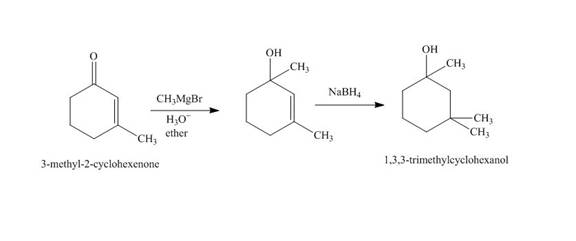
Explanation of Solution
The reaction of
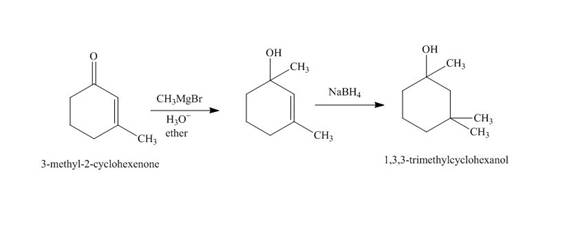
Figure 2
The synthesis of
(c)
Interpretation:
The synthesis of
Concept introduction:
An ester is a derivative of carboxylic which is obtained by replacing the
Answer to Problem 22.82AP
The synthesis of
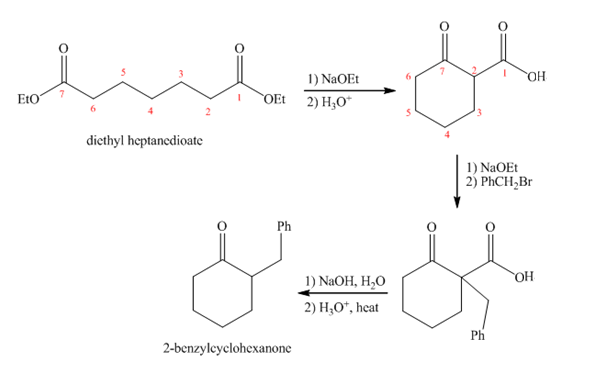
Explanation of Solution
Diethyl heptanedioate in presence of

Figure 3
The synthesis of
(d)
Interpretation:
The synthesis of
Concept introduction:
An ester is a derivative of carboxylic which is obtained by replacing the
Answer to Problem 22.82AP
The synthesis of
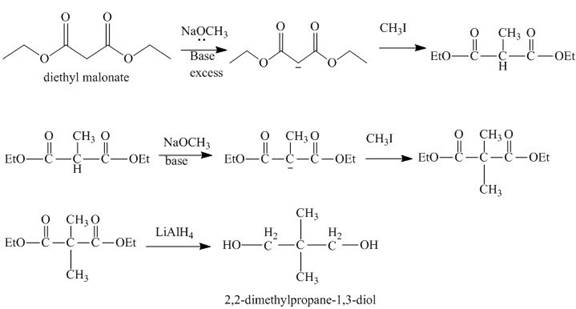
Explanation of Solution
The reaction of diethyl malonate in presence of base and then

Figure 4
The synthesis of
(e)
Interpretation:
The synthesis of
Concept introduction:
An ester is a derivative of
Answer to Problem 22.82AP
The synthesis of
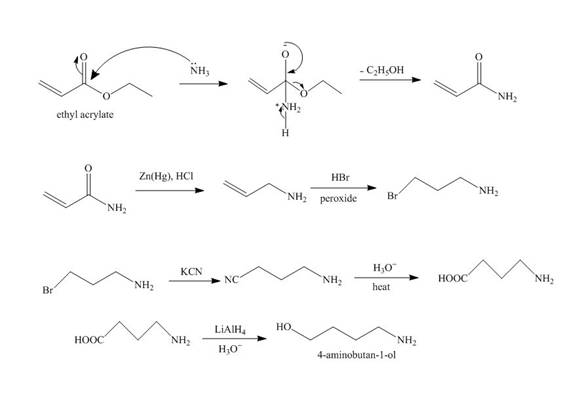
Explanation of Solution
The reaction of ethyl acrylate with ammonia forms amide derivative. It undergoes reduction reaction with

Figure 5
The synthesis of
(f)
Interpretation:
The synthesis of
Concept introduction:
In organic chemistry, the compound with the molecular formula
Answer to Problem 22.82AP
The synthesis of
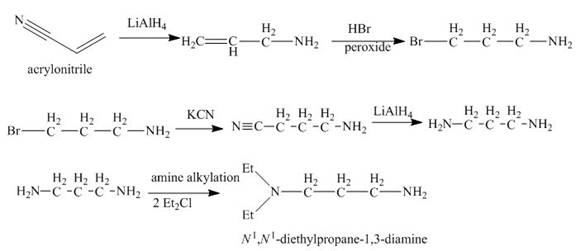
Explanation of Solution
The reaction of acrylonitrile with
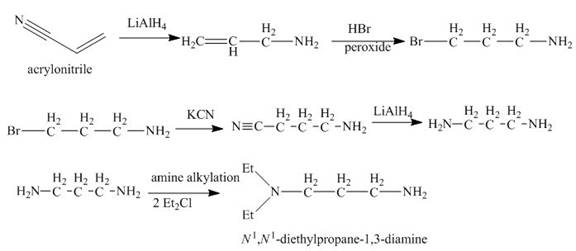
Figure 6
The synthesis of
(g)
Interpretation:
The synthesis of
Concept introduction:
Carboxylic acid is a class of organic compound contains a
Answer to Problem 22.82AP
The synthesis of
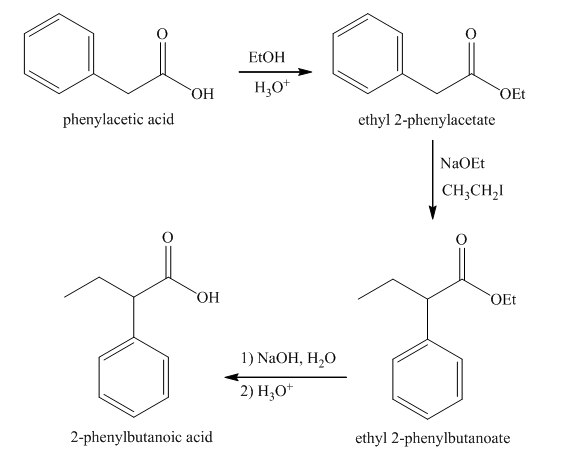
Explanation of Solution
Esterification of phenylacetic acid forms ethyl

Figure 7
The synthesis of
(h)
Interpretation:
The synthesis of
Concept introduction:
In Aldol condensation reaction, the base abstracts an acidic proton from the
Answer to Problem 22.82AP
The synthesis of
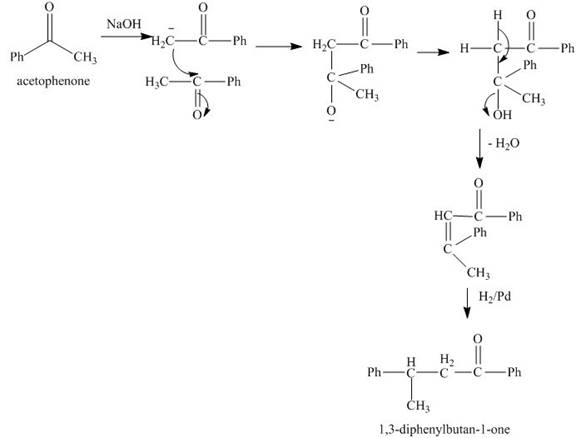
Explanation of Solution
The reaction of acetophenone in presence of base abstracts a

Figure 8
The synthesis of
(i)
Interpretation:
The synthesis of deuterium substituted diphenylethanol from phenylacetic acid is to be stated.
Concept introduction:
Carboxylic acid is a class of organic compound that contains a
Answer to Problem 22.82AP
The synthesis of di-deuterium substituted diphenyl ethanol from phenylacetic acid is shown below.
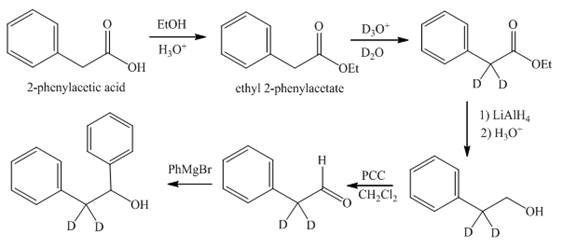
Explanation of Solution
Reaction of

Figure 9
The synthesis of deuterium substituted diphenyl ethanol from phenylacetic acid is shown in Figure 9.
(j)
Interpretation:
The synthesis of tetra-deuterium substituted product from cyclohexanone is to be stated.
Concept introduction:
In organic chemistry, the carbonyl compound is a class of functional group which contains a
Answer to Problem 22.82AP
The synthesis of tetra-deuterium substituted product from cyclohexanone is shown below.

Explanation of Solution
The reaction of cyclohexanone with

Figure 10
The synthesis of tetra-deuterium substituted from cyclohexanone is shown in Figure 10.
(k)
Interpretation:
The synthesis of
Concept introduction:
Friedel Craft acylation is an electrophilic aromatic substitution reaction. In this reaction, the synthesis of the monoacylated product takes place from the reaction between aromatic rings and acyl chlorides. The organic reaction in which an organohalide is reacted with alcohols or phenols to form ethers is Willamson synthesis reaction.
Answer to Problem 22.82AP
The synthesis of
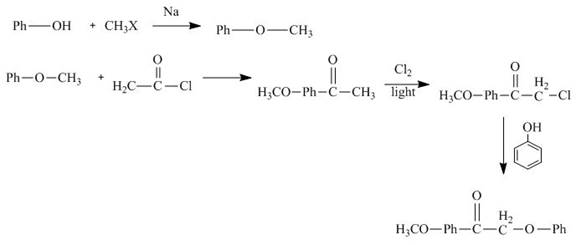
Explanation of Solution
The reaction of phenol with methyl halide forms methylphenyl ether. It reacts with acetyl chloride followed by chlorination in sunlight. Then it reacts with phenol to give the desired product. The synthesis of

Figure 11
The synthesis of
(l)
Interpretation:
The synthesis of
Concept introduction:
An ester is a derivative of carboxylic which is obtained by replacing the
Answer to Problem 22.82AP
The synthesis of
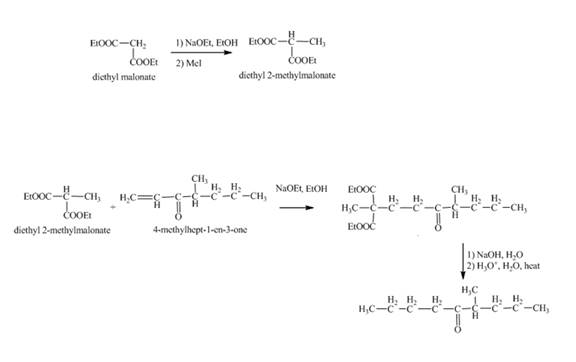
Explanation of Solution
Methylation of diethyl malonate in the presence of sodium ethoxide and

Figure 12
The synthesis of
(m)
Interpretation:
The synthesis of
Concept introduction:
An ester is a derivative of carboxylic which is obtained by replacing the
Answer to Problem 22.82AP
The synthesis of
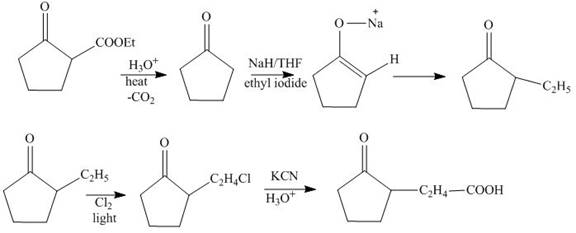
Explanation of Solution
The hydrolysis reaction of

Figure13
The synthesis of
Want to see more full solutions like this?
Chapter 22 Solutions
EBK ORGANIC CHEMISTRY STUDY GUIDE AND S
- Synthesize 2-Ethyl-3-methyloxirane from dimethyl(propyl)sulfonium iodide using the necessary organic or inorganic reagents. Draw the structures of the compounds.arrow_forwardSynthesize 2-Hydroxy-2-phenylacetonitrile from phenylmethanol using the necessary organic or inorganic reagents. Draw the structures of the compounds.arrow_forwardSynthesize N-Methylcyclohexylamine from cyclohexanol using the necessary organic or inorganic reagents. Draw the structures of the compounds.arrow_forward
- Synthesize N-Methylcyclohexylamine from cyclohexanol using the necessary organic or inorganic reagents. Draw the structures of the compounds.arrow_forwardIf possible, please provide the formula of the compound 3,3-dimethylbut-2-enal.arrow_forwardSynthesize 1,4-dibromobenzene from acetanilide (N-phenylacetamide) using the necessary organic or inorganic reagents. Draw the structures of the compounds.arrow_forward
- Indicate the products obtained by mixing (3-oxo-3-phenylpropyl)triphenylphosphonium bromide with sodium hydride.arrow_forwardWe mix N-ethyl-2-hexanamine with excess methyl iodide and followed by heating with aqueous Ag2O. Indicate the major products obtained.arrow_forwardIndicate the products obtained by mixing acetophenone with iodine and NaOH.arrow_forward
- Indicate the products obtained by mixing 2-Propanone and ethyllithium and performing a subsequent acid hydrolysis.arrow_forwardIndicate the products obtained if (E)-2-butenal and 3-oxo-butanenitrile are mixed with sodium ethoxide in ethanol.arrow_forwardQuestion 3 (4 points), Draw a full arrow-pushing mechanism for the following reaction Please draw all structures clearly. Note that this intramolecular cyclization is analogous to the mechanism for halohydrin formation. COH Br + HBr Brarrow_forward

 Organic ChemistryChemistryISBN:9781305580350Author:William H. Brown, Brent L. Iverson, Eric Anslyn, Christopher S. FootePublisher:Cengage Learning
Organic ChemistryChemistryISBN:9781305580350Author:William H. Brown, Brent L. Iverson, Eric Anslyn, Christopher S. FootePublisher:Cengage Learning

